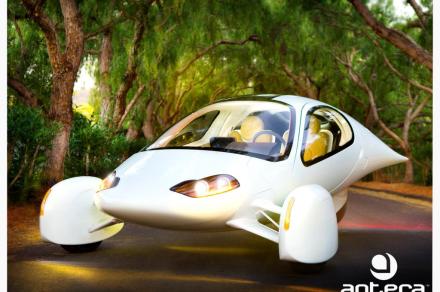Aptera’s 3-wheel solar EV hits milestone on way toward 2025 commercialization
By
Nick Godt

Image used with permission by copyright holder
EV drivers may relish that charging networks are climbing over each other to provide needed juice alongside roads and highways.
But they may relish even more not having to make many recharging stops along the way as their EV soaks up the bountiful energy coming straight from the sun.
That’s the bet from Aptera Motors, a crowdfunded, California-based maker of solar-powered electric vehicles.
Aptera says it just completed a successful test drive of PI-2, the first production-intent version of its futuristic-looking two-seater, three-wheel solar electric vehicle. The EV’s latest version was engineered to rigorously test performance metrics such as range, solar charging capability, and efficiency, Aptera says.
“Driving our first production-intent vehicle marks an extraordinary moment in Aptera’s journey,” said Steve Fambro, Aptera’s Co-Founder and co-CEO, in a statement. “It demonstrates real progress toward delivering a vehicle that redefines efficiency, sustainability, and energy independence.”
Aptera says it already has over 50,000 reservations for its EV, which are scheduled to start being delivered in the second quarter of 2025. Last year, it unveiled a $33,200 launch version featuring an under-6-second zero-to-60 mph acceleration time, a battery pack providing a range of 400 miles, and a solar charge range of 40 miles per day.
The Aptera EV also features Tesla’s North American Charging Standard (NACS) port to charge its battery.
The company said its production-intent models will continue to evolve over time as they undergo further tests, including key metrics such as solar charging rates and watt-hours per mile.
Other versions of the Aptera EV were said to provide as much as 1,000 miles of range with a zero-to-60 mph acceleration in 3.5 seconds.
Aptera has so far raised over $100 million since launching a crowdfunding program three years ago.
Solar-powered electric vehicles are also being developed by the likes of Germany’s Sono Motors and the Netherlands’ Lightyear, and by big automakers such as Hyundai and Mercedes-Benz.

Rivian gets Knight Rider spooky for Halloween

Rivian vehicles are known for giving drivers the chance to take the party on the road, whether it’s stowing a travel kitchen onboard or using its elaborate software systems to spice things up.With Halloween just around the corner, the automaker based in Plymouth, Michigan, is pulling out some treats from its bag of tricks: Rivian owners are getting a number of options to turn their vehicles into traditional spooky or full-on sci-fi entertainment hubs.A software update available on the Rivian Mobile App until November 4 provides Car Costumes, which take over the vehicle’s screen, lighting, and sound systems while in park to transform it into three different cars.Nostalgic fans of the Knight Rider TV series will be pleased with the option to turn their Rivians into the famous K.I.T.T. crime-fighting car. After choosing the option on the app, the car’s interior display system features K.I.T.T.’s diagnostics on screen while playing the original show intro music. Here’s an extra treat for Rivian Gen 2 owners: The exterior light bar will feature K.I.T.T.’s iconic beaming red light while playing its scanner sound effect.No-less nostalgic fans of Back to the Future movies will also get their treat with a chance to turn their vehicle into the DeLorean Time Machine. With this option, the screen turns into the classic time-traveling interface while the audio system plays the movie’s music and acceleration sound effects. Once again, Rivian Gen 2 owners get an extra treat. Hitting the key 88 mph button will engage the car’s lighting and sound effects in the front and back of the car to whizz you through the sound barrier.For a more traditional spooky time, you can opt for the Haunted Rivian car costume, featuring eight different sound effects and three different color themes. Static and ghosts will take over your interior display.Rivian Gen 1 owners get a green animation on the outside of the vehicle. Gen 2 owners can turn the exterior light bar into whichever color option they find most frightful.
The Nissan Rogue is joining the plug-in hybrid club in 2025

It might have taken a while, and slumping sales of its most popular SUV, but Nissan has finally taken the step to offer hybrid vehicles in the U.S. The Japanese automaker will add a plug-in hybrid (PHEV) powertrain to the 2026 Rogue compact SUV, which should be available stateside sometime next year, Nissan Americas chief planning officer Ponz Pandikuthira told Automotive News.A plug-in hybrid electric vehicle (PHEV) typically runs on electric power until its battery is almost depleted, at which point it automatically switches over to using a gasoline-powered internal combustion engine. The battery can be recharged conventionally from the outside or through regenerative braking.
While Nissan has been offering popular fully electric vehicles (EVs) such as the Leaf and the Ariya for years, it has surprised many by not joining the hybrid bandwagon, especially for the Rogue. Competitors such as the Toyota RAV4 and the Honda CR-V, which do provide the part-fuel, part-electric power capacity, have seen their sales surging. Meanwhile, sales of the Rogue have slumped this year.
That’s why Nissan is partnering with Mitsubishi to start offering its first-ever electrically assisted car in the U.S. next year.
According to the Automotive News report, the Rogue will be outfitted with a similar powertrain found in the Mitsubishi Outlander. In that model, a 2.4-liter gas engine powers the front wheels, while two electric motors create an all-wheel drive system that can either work on its own or in conjunction with the gas engine. As the Outlander is able to deliver 248 horsepower, that would make the Rogue PHEV more powerful than the existing model’s 201 hp. The Outlander is also rated for 38 miles of electric driving by the EPA.
In addition, Nissan is planning to bring its non-plug-in, e-Power series hybrid technology to the U.S. in 2026. This technology, already available outside the U.S., also uses electric motors to power the wheels while using the gas engine to charge the battery.
Are self-driving cars the death of car ownership?

Self-driving cars are coming. It remains to be seen how long that will take. Plenty of vehicles can more or less drive themselves on highways, but for now, they still can’t completely reliably drive themselves on all streets, in all conditions, taking into account all different variables. One thing is clear, though: the tech industry sees autonomous driving as the future of personal transportation, and they’re spending billions to reach that goal.
But what happens when we get there? Tesla made headlines for not only announcing its new Cybercab fully autonomous vehicle, but simultaneously claiming that customers will be able to buy one. That’s right, at least if Tesla is to be believed, the Cybercab doesn’t necessarily represent Tesla building its own Uber-killing fleet of self-driving cars, but instead giving people the ownership over the self-driving car industry.

